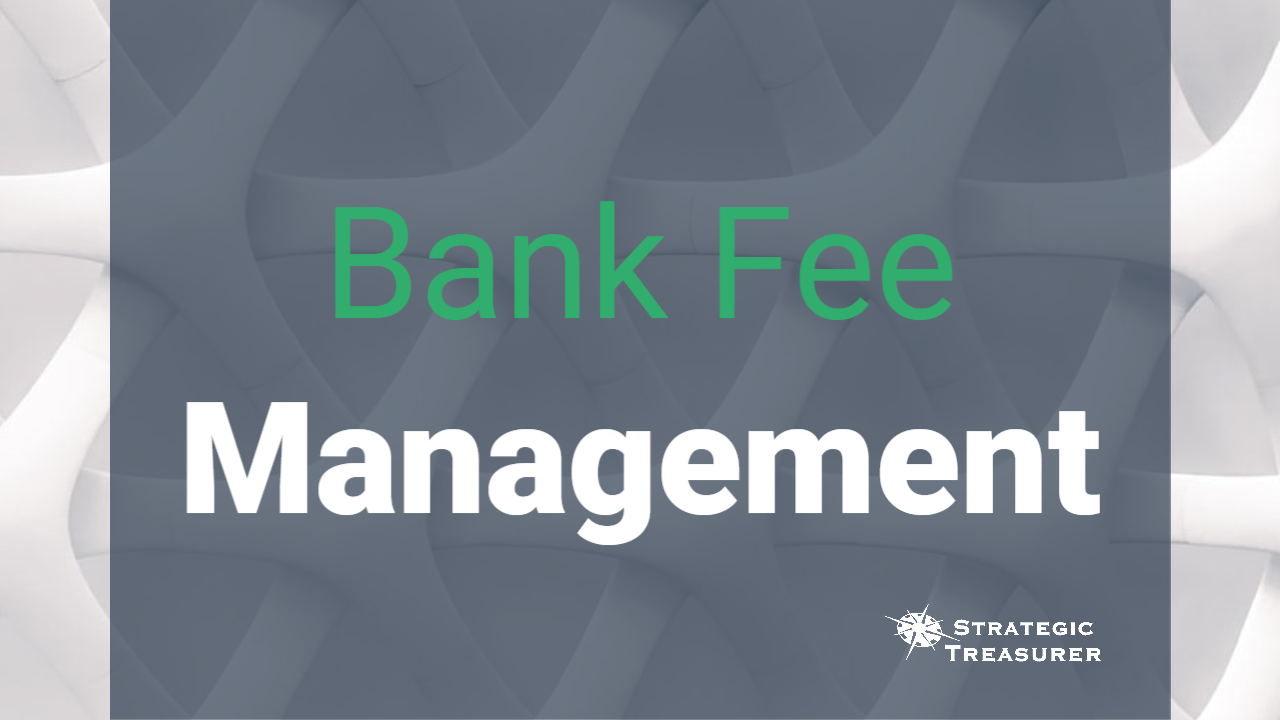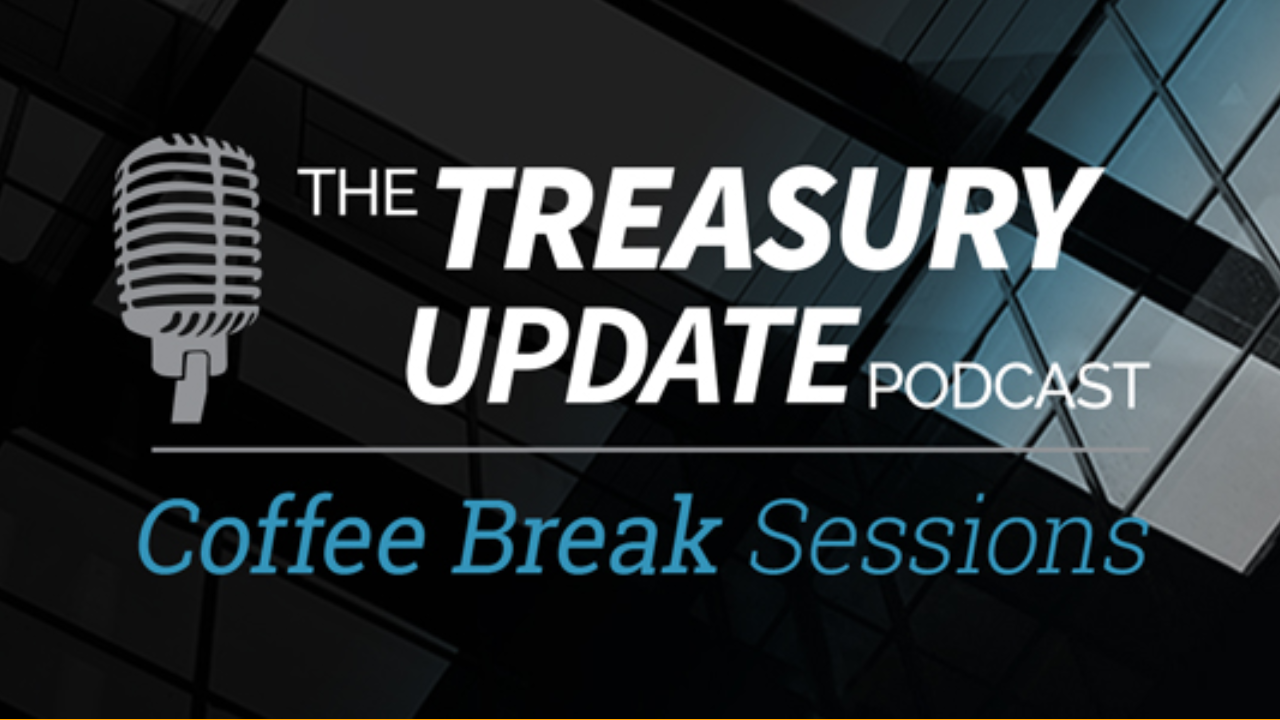
Session 24
Coffee Break Session:
What Is Bank Account Management?
What is Bank Account Management? Coffee Break Session Host Alexa Cook catches up with Stephanie Villatoro, Senior Consultant at Strategic Treasurer, to discuss what Bank Account Management (BAM) is. They cover some of the key elements of BAM and how it can vary across the globe. Listen in and learn a little bit about Bank Account Management.
Host:
Alexa Cook, Strategic Treasurer


Speaker:
Stephanie Villatoro, Strategic Treasurer


Episode Transcription - CBS Episode 24: What is Bank Account Management
Alexa Cook:
Hey, guys. Welcome to the Treasury Update Podcast: Coffee Break Sessions, the show where we cover foundational treasury topics and questions in about the same amount of time it takes you to drink your coffee. This is your host, Alexa Cook, and today, I’m joined again with Stephanie Villatoro, Senior Consultant at Strategic Treasurer. Welcome back, Stephanie.
Stephanie Villatoro:
Hi, Alexa, and thank you for having me today.
Alexa Cook:
Yeah, of course. So today, we’re going to be switching it up a little bit and moving away from the payment series that we’ve kind of been doing with Stephanie. And we’re going to touch on what is bank account management? So to start, Stephanie, can you just start by providing us with a quick overview of what bank account management is from a corporate treasury perspective?
Stephanie Villatoro:
Certainly, Alexa. Bank account management is really just what it is, it’s managing your accounts. But it’s also managing your bank relationships, keeping that open line of communication, updating your accounts, the data management around it as well. So that’s one of the bigger things that we see with just bank account management from a corporate treasury perspective. It also is oversight of your bank accounts, relationships from a global perspective.
Stephanie Villatoro:
If you’re in many countries, it’s also looking at frauds and controls that you have in place on your accounts, and protecting those assets. Because look, from a corporate treasury perspective, it is looking at… Your main goal is to protect the company’s assets, and that’s cash around the world in your bank accounts, making sure you have that in place.
Alexa Cook:
Right. That makes sense. So what are some of the key elements or key pieces of bank account management?
Stephanie Villatoro:
As I mentioned, just previously in the overview, it’s managing those accounts, whether it’s opening a bank account around the world, closing them once they’ve… Maybe you’ve closed out an entity, in closing the accounts or you’re changing banks, so that might entail opening and closing, keeping your signers up to date as well as sometimes that’s a manual process with your bank relationships. So, contacting them and getting the documentation required for any changes, as well as also eBAM, that’s slowly been implemented over the last 10 plus years.
Stephanie Villatoro:
But I’m seeing some spins on that in the marketplace as well, where banks are using their portals for eBAM, as well as SWIFT. Also, KYC requirements, sometimes if you’re making a change and they haven’t done KYC, that is now a regulatory requirement for banks to know their customers. So they will require certain documentation. It’s usually legal documents, and there are some systems out in the marketplace now for KYC to assist that process, because it’s very painful.
Alexa Cook:
I was just going to jump in and say, you said the words eBAM and KYC, and I think eBAM is electronic bank account management, and then KYC is know your customer, is that correct?
Stephanie Villatoro:
Yes, it is. So eBAM is just a way to electronically transmit documentation. And maybe I should explain that a little bit more, but it is typically, you’re printing out paper, you’re filling out the documents, signing them with a wet signature and then scanning those or mailing them to different banks around the world. That’s still required in some jurisdictions, but eBAM started many years ago. And that was a way to electronically share documentation to open, close or change an account. Some banks and countries allow it, some don’t. But it’s been a very slow process of getting that taken off.
Stephanie Villatoro:
And then KYC, know your customer, is more documentation that’s required of you to the bank for new accounts, for any kind of changes, if they haven’t done KYC in a while with you, those regulations or requirements that are regulatory are required by the bank to make sure to protect themselves from other types of things that can’t go on, like money laundering and things like that, that they need to make sure they know who their customers are.
Stephanie Villatoro:
And then the other couple of elements or pieces of bank account management is the data management, making sure you have a good record of everything that you have out there. So bank accounts, current documentation, as well as just a listing of those accounts and signers electronically is helpful as well. There are different systems that manage bank accounts, whether it’s in a TMS or a dedicated system. Most use common things like Excel. We can talk about that a little bit later. And then compliance, having that data and good accurate records also assist in different compliance efforts like FBAR, which is foreign bank account reporting. That’s required of any company with a foreign bank account. They have to report those, as well as any signers, US or US citizens or US residents that are signers on accounts that have the ability to transact on it.
Stephanie Villatoro:
That has to be as well reported. And when you’re thinking of that, it’s beyond just the actual physical bank account. You actually have to track your portal users and those that have capability to move funds through a portal because according to FinCEN, that is also a signer according to them.
Alexa Cook:
Great. And I know you were talking about some of the global complications or pieces, or you alluded to that in the overview, and then at the start of those key elements before I took you on a tangent asking you to explain those acronyms. But what are some of the differences that you might see between the countries in regards to bank account management? Are there any country-specific requirements that you’ve seen?
Stephanie Villatoro:
Yes, there’s different requirements locally. And one thing I didn’t mention before is just another key element, is services, and that ranges as well by country. So the services that you have on your account. I know payments are a big one, reporting’s a big one, but fraud controls are different from country to country. And that’s one of the major differences as well.
Stephanie Villatoro:
One is things to think of when you’re looking at country-specific is if you’re going into a new country or just one that you’re currently managing, one is language barriers. Documentation requirements may require documents to be in a specific language. Sometimes they’ll give you the English version of it if you’re US-based. Sometimes they do not, and you have to have that translated. That includes your terms and conditions, your bank documentations, the resolution, the signature cards are all in another language.
Stephanie Villatoro:
Sometimes it’s interesting in that regard. Sometimes there’s in-person requirements, which is interesting when you’re opening or closing an account, and you have to have someone physically at a branch to sign documents to open an account, which makes it a little challenging if you’re managing things from afar. My past, we had someone sitting in Hong Kong and had to open an account in Macau, and he literally had to take the little speed boat over to Macau to physically sign documents in-person.
Stephanie Villatoro:
And from a language perspective, which was interesting in Macau, they are required to be in Portuguese. So you’re signing documents in Portuguese. Which is interesting in Asia Pacific, and then, things I’ve seen, physically closing an account, making sure the balance has to be zero beforehand. But also having to be in-person at the branch, to close the account, instead of just submitting a letter to close. There’s other requirements I’ve seen around the world with foreign currency accounts.
Stephanie Villatoro:
So, if your bank account is held in a foreign currency of the local jurisdiction. So an example is that one is Sri Lanka. If it’s not in Sri Lankan rupee, say it’s US dollar or Sing dollar, whatever that might be, if you’re opening an account, that’s a foreign currency to the local jurisdiction. They require government approval. So you have to submit documentation through the legal route, to have approval from the government to open those accounts. And then other things to think of when you’re looking at just global bank accounts, is just closed currencies, where you can’t trade offshore. Examples of that one would be Indian rupee, where you can’t just easily exchange. It has to be on shore.
Alexa Cook:
Okay. I think back in the overview, you did touch a little bit on the system. So maybe we can just circle back to that and talk about some of the systems that are typically used today. And I’m going to preface this and say I use the word systems very loosely, because in my experience, sometimes we would reference our bank account management as a system, and it wasn’t technically a system. I’ll leave it there and let you answer that one.
Stephanie Villatoro:
Well, there’s two types of data management with bank accounts. There’s the physical forms that you’ve signed and scanned, and that might be PDFs. And it could be actual paper, where you have them in folders. So, that’s one thing. You have to look at where you store those on Sharefile or where everyone has access to them. Sometimes they’re managed locally and it’s very loosely organized, but that’s one form of management of your data, is to have the most recent, at least, history of physical documents of any changes made to your accounts. We could get into that in another tangent, because that’s where bank audits come into play of making sure your system matches your bank systems, that you have the same data of who’s physically signers on the accounts. Because sometimes, banks have multiple systems they have to update, and they don’t always get done.
Stephanie Villatoro:
So if you remove someone, he may have been removed from five out of six systems, but not all six. So therefore, he still has authority on those accounts at the bank. That gets under risk management. And then the other type of data is just that physical data warehouse of a list of your accounts, a list of who has authority on those accounts from a portal standpoint as well as a legal signer. That is the data that we’re talking about. And then the workflows associated with that to make changes to it. I would say the majority of people hold that in Excel. That is one type of system, and that’s what you’re talking about loosely. Smaller companies, those without systems in place in treasury will use Excel. And it is a good tool, but as it gets larger and larger, that becomes more hard to manage because it’s prone to errors because of the requirement that someone has to go in and update that.
Stephanie Villatoro:
And that holds true with a system as well. If you’re not updating Excel, what makes you think you’re going to update your system if you have that in place? But systems also have workflows where you can actually trigger workflows and do kind of like an eBAM process, but it’s more held within the system. So the systems out there can be a dedicated bank account management system. It’s a one-off, it just does bank account management. And there’s also treasury management systems that have modules for their bank account management. It’s nice to have that held in one place because they do tie together very closely with reporting, making sure you have access and visibility to all of your accounts, but those are the ways that can be managed.
Alexa Cook:
So I know you mentioned it back in our brief key elements at the beginning here, and I know KYC is such a big and important topic in banking. But what kind of KYC options do some of these bank account management or BAM systems offer?
Stephanie Villatoro:
KYC systems aren’t typically held within a bank account module today, or a bank account system that holds all that data. Sometimes you can have those documents readily available, but within an organization, you have documentation with your legal department, you have them in the local jurisdiction.
Stephanie Villatoro:
Treasury is kind of the last person to get all of that, and they have to request it. But there are systems out there that help manage that process to streamline KYC for banks. One of the biggest ones I think I’ve heard is SWIFT and Bloomberg. There’s another one called IHS Market. There’s others out there that are up and coming, but this is just a repository of data about each of the entities that you have, where the bank, if you’re opening an account for a particular entity, they can go pull that most recent documentation out there.
Stephanie Villatoro:
This is relied on the entity. So the corporation actually keeping those records up to date in that online system or that online marketplace, where that information can be shared with banks and different banks, they’re utilizing those systems as well. So typically, what I’m seeing out there is the banks are paying for it because they want to streamline their back office processing and bring revenue in. And they’re typically free for corporate clients to be a part of those. So that’s one way I see, it still relied on the corporations putting the necessary data out there for these bankers to be able to pull that data from whether it’s SWIFT or Bloomberg or IHS Market or other systems that are out there.
Alexa Cook:
And I think we’re about at time. So I’m just going to do a quick recap of not everything you covered, but some of just the key points. So to start, what is bank account management? That’s really just the management of bank accounts and the data management around it. And I think the goal of that is the oversight of really all of your bank accounts on either a regional, national, or even global level, depending on how maybe the treasury is set up or how that’s determined to be managed.
Alexa Cook:
And then some of the key elements or key pieces of bank account management are really going to be those bank account openings, closings, or changes in signers, and that’s either done manually or across eBAM. And then, there’s KYC systems and considerations, and then data management and systems and considerations as well. And then of course, we’ve always got to be thinking about compliance for things such as FBAR or even FATCA and stuff along those lines.
Stephanie Villatoro:
One other thing to mention there, as we talked about compliance, and I know we focus in on bank accounts, but there are other types of financial accounts, we’ll say, that are according to FinCEN, and that’s driving... FinCEN kind of drives what you have to manage in treasury from this standpoint. But it can include other items, anything that holds a value from a standpoint of balances is considered an account according to FinCEN.
Stephanie Villatoro:
You’ll laugh, but it’s like a cell phone company’s mobile account can actually transfer funds to and from either your employees or vendors. Those can hold funds and they funds. So that’s considered a financial account. Not a SWIFT way, not a wired way, like wiring money to a bank account, but it is one as well. This could also be different financial instrument accounts, investments, and things like that as well. Just to kind of broaden your scope there a little bit outside of just physical bank accounts.
Alexa Cook:
All right. Well, thank you, Stephanie. I appreciate your time today. And for joining me on today’s podcast, and to all of our listeners, don’t forget to tune back in every first and third Thursday of the month for a new episode. And if you have any questions, comments, or topics you’d like us to cover, please send us an email at Podcast@StrategicTreasurer.com. Thanks again, Stephanie.
Stephanie Villatoro:
Thank you, Alexa.
OUTRO:
This podcast is provided for informational purposes only, and statements made by Strategic Treasurer, LLC on this podcast are not intended as legal, business, consulting, or tax advice. For more information, visit and bookmark StrategicTreasurer.com.
Strategic Treasurer’s Bank Fee Management Program
Strategic Treasurer’s Bank Fee Management program is a comprehensive package that provides a level of service beyond what a software program or basic outsourcing can offer.
Coffee Break Sessions – A Treasury Update Podcast Series
A part of the Treasury Update Podcast, Coffee Break Sessions are 6-12 minute bite-size episodes covering foundational topics and core treasury issues in about the same amount of time it takes you to drink your coffee. The show episodes are released every first and third Thursday of the month with Special Host and Treasury Consultant Alexa Cook of Strategic Treasurer.




